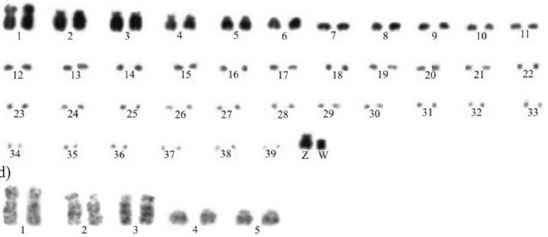NOR- bearing as a plesiomorphic characteristic in Mimus saturninus (Passeriformes Mimidae)
DOI:
https://doi.org/10.20873/jbb.uft.cemaf.v5n2.kretschmerKeywords:
Karyotype, macro and microchromosomes, chromosome bandingAbstract
The order Passeriformes is the largest group of species karyotyped among birds, however little is known about the cytogenetic of the Mimidae family, registering only karyology basic data (giemsa staining). The aim of this study was to analyze the chromosomal complement from the species Mimus saturninus by conventional staining and differential chromosome banding. Diploid number and chromosome morphology were determined, as well as the distribution pattern of constitutive heterochromatin (CBG-banding), GTG-banding andAgNOR staining (NORs). The Chalk-browed Mockingbird has 2n=80. The first and fourth pairs are submetacentric and the second, third and fifth are acrocentric. The remaining chromosomes pairs of the complement have telocentric morphology. The Z chromosome is submetacentric and the W is metacentric. CBG-banding showed positive staining in the pericentromeric region of most macrochromosomes and microchromosomes and also at Z chromosome, differently from W chromosome which appeared totally heterochromatic. The GTG-banding was similar to Gallus gallus and in other species which have already been GTG-banded. The NORs were identified in a pair of microchromosomes characterized by presenting a remarkable secondary constriction. This can be considered as a plesiomorphic characteristic for M. saturninus once baseline groups (Paleognathae) also showed a pair of microchromosomes bearing NORs.

Published
How to Cite
Issue
Section
License
Copyright (c) 2024 - Journal of Biotechnology and Biodiversity

This work is licensed under a Creative Commons Attribution 4.0 International License.
Authors who publish with this journal agree to the following terms:
Authors retain copyright and grant the journal right of first publication with the work simultaneously licensed under a Creative Commons Attribution License (CC BY 4.0 at http://creativecommons.org/licenses/by/4.0/) that allows others to share the work with an acknowledgement of the work's authorship and initial publication in this journal.
Authors are able to enter into separate, additional contractual arrangements for the non-exclusive distribution of the journal's published version of the work (e.g., post it to an institutional repository or publish it in a book), with an acknowledgement of its initial publication in this journal.
Authors are permitted and encouraged to post their work online (e.g. in institutional repositories or on their website) prior to and during the submission process, as it can lead to productive exchanges, as well as earlier and greater citation of published work (Available at The Effect of Open Access, at http://opcit.eprints.org/oacitation-biblio.html).


